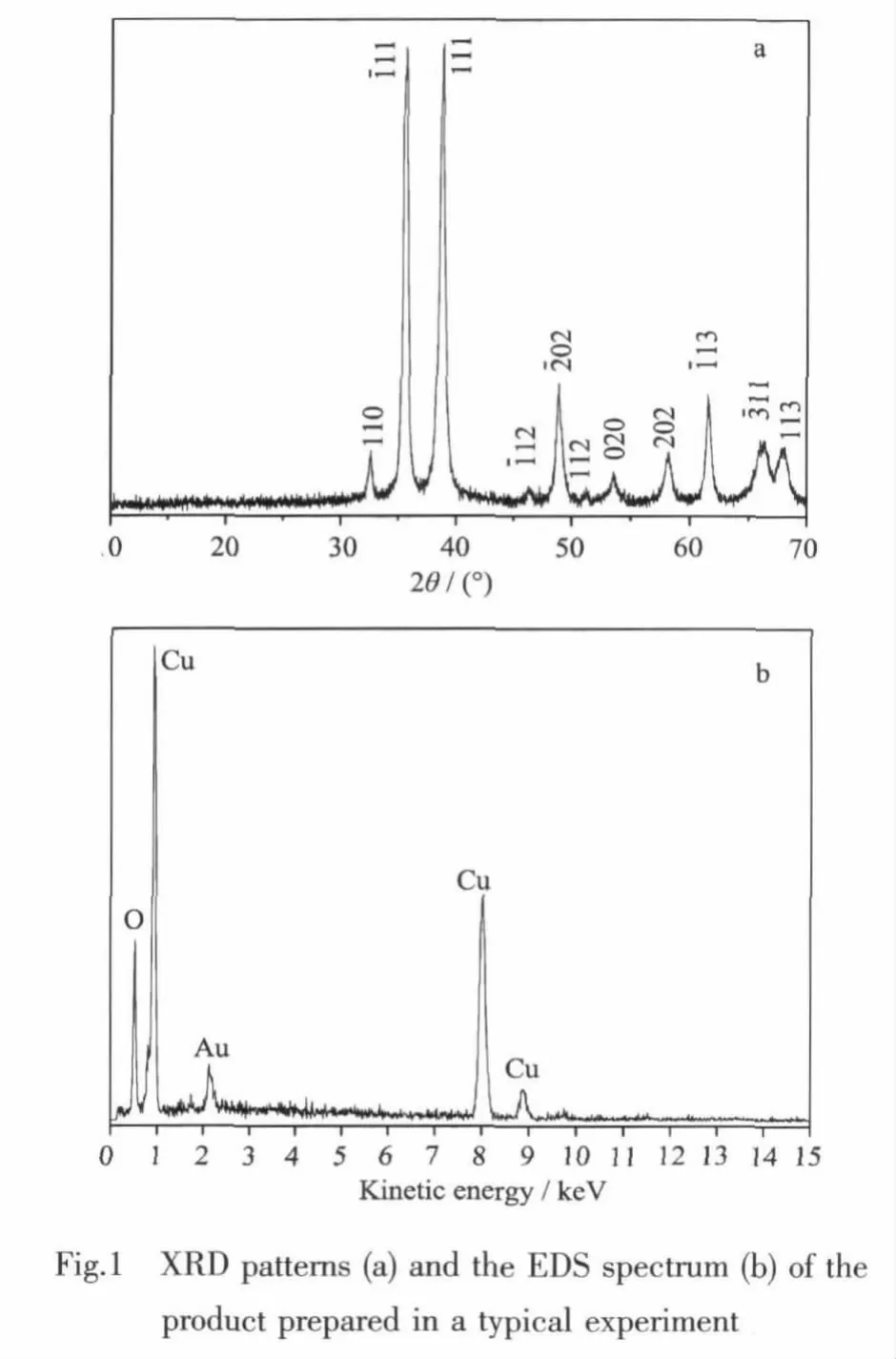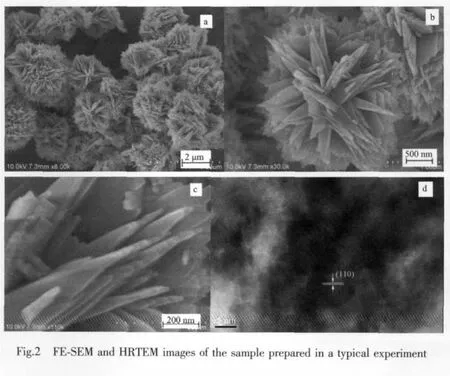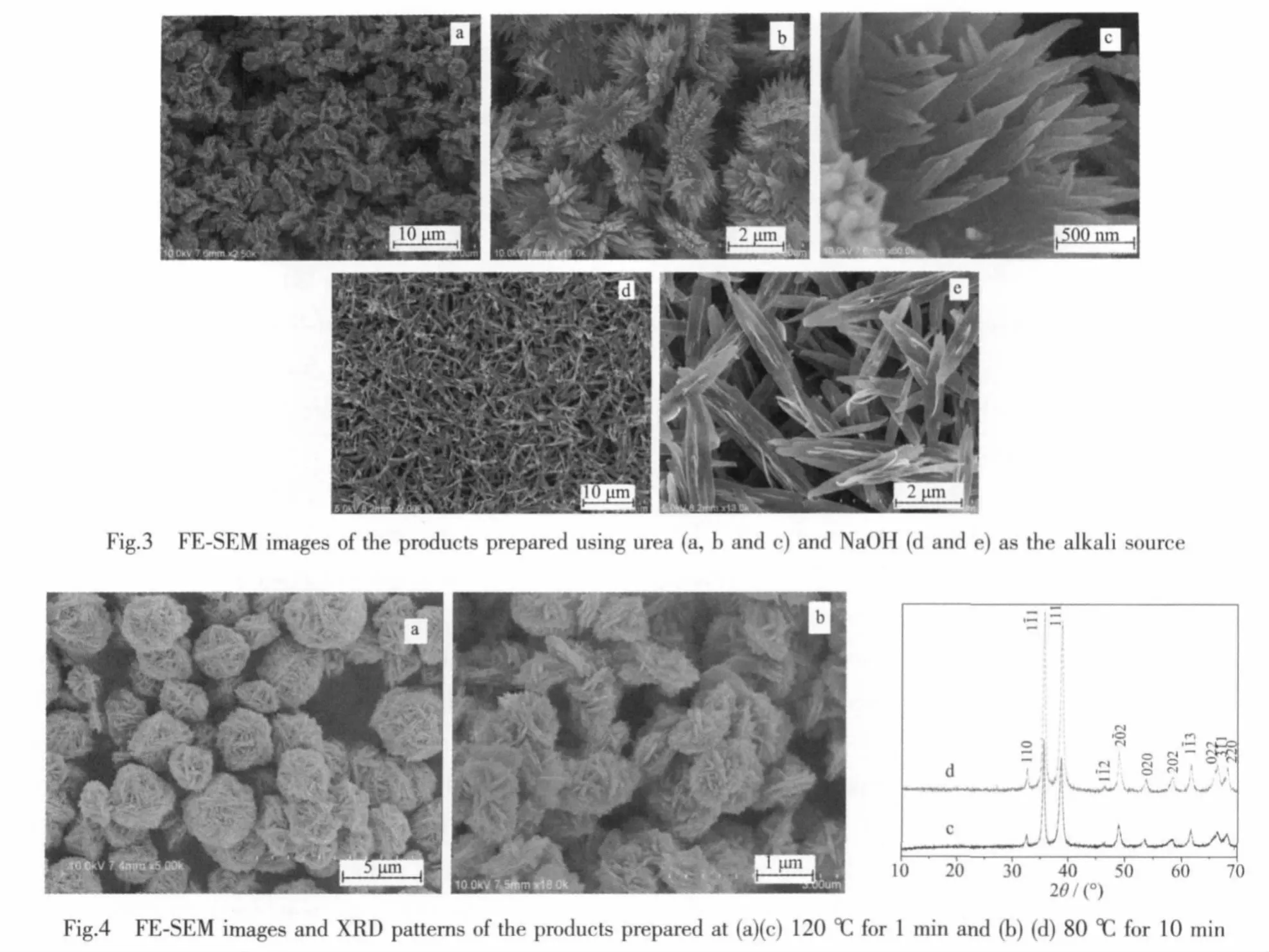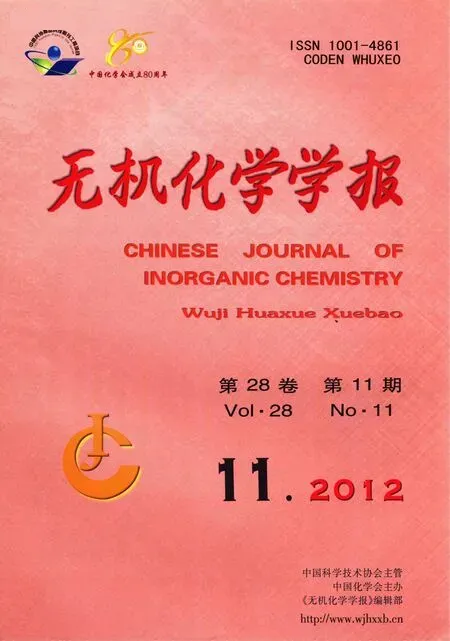微波辅助水热法制备花状氧化铜
2012-11-09曹霄峰李兆乾陈学太
曹霄峰 张 雷 李兆乾 陈学太
微波辅助水热法制备花状氧化铜
曹霄峰 张 雷 李兆乾 陈学太*
(南京大学配位化学研究所,配位化学国家重点实验室,南京微结构国家实验室,南京大学化学化工学院,南京 210093)
以硝酸铜为铜源,氨水为碱源,通过微波辅助水热法制备了花状CuO微纳米材料。制备过程中没有使用表面活性剂或离子液体等软模板剂。利用X-射线衍射、电子能谱、场发射扫描电镜以及高分辨透射电镜表征了产物的物相和形貌。对照实验显示碱源对产物形貌有着很大的影响。通过时间演化实验研究了花状CuO的生长过程。结果显示反应过程经历了Cu2(OH)3NO3和Cu(OH)2两种中间产物。
氧化铜,花状,微波水热法
Copper oxide (CuO),a typical narrow p-type semiconductor with a band gap of 1.2 eV[1-2],has attracted a great deal of attention because of its potential technological applications in heterogeneous catalysts,gas sensors,lithium ion electrode materials,solar cells,photocatalysts,and so on[3-5].Up to now,CuO nanomaterials with different morphologies have been prepared by several methods,including thermal oxidation, electrochemical method, sonochemical method,hydrothermal/solvothermal method,etc[6-10].
Recently,microwave has been widely used in organic synthesis and nanomaterials preparation.Compared to the traditionalheating,microwave heating is simple, rapid, uniform, efficient,economical,and environmentally friendly.Sofar,several studies have been performed on thepreparation of CuO nanomaterials via the microwaveassisted solution-phase process.Severalkindsof morphologies such as nanoparticles, nanoleaves,nanosheets,nanowhiskers,nanorods,chrysanthemumlike,flower-like,and sea urchin-like have been prepared by microwave-assisted solution-phase process[11-15].The surfactants or the ionic liquids were usually used to prepare the flower-like CuO hierarchicalnano-/microstructures[16-19].The use of soft template usually pollutesthesample and the post-processing is tedious.In the present paper,we report the preparation of flowerlike CuO nanomaterials via a 1 min microwave-assisted hydrothermal process without the use of any surfactants or ionic liquids.The effect of the alkali source on the morphologies has been studied.The crystal growth process of as-prepared CuO is suggested.
高管技术专长对创新投入的影响研究....................................................................................................................................刘力钢 孙 亚(1)
1 Experimental
Allreagentswere purchased from Shanghai Chemical Company and used without further purification. All samples were prepared in a microwave system(2.45 GHz,Discover S-Class,CEM)equipped with in situ magnetic stirring.The exposure time and temperature were programmed. The automatic temperature-control system allowed continuous monitoring and control of the internal temperature of the reaction system (1℃).The preset profile (desired time and temperature)was followed automatically by continuously adjusting the applied microwave power.
In a typical preparation procedure,Cu(NO3)2·6H2O(1.0 mmol,AR)was dissolved in H2O(9.5 mL).Then 0.5 mL ammonia solution (30%)was added dropwise to the above solution under continuous stirring.The color of the solution gradually changed from light blue to dark blue.The reaction solution was stirred at room temperature for 10 minutes and then transferred to a 35 mL round-bottom flask.After treating the mixture at 150℃for 1 min under microwave irradiation, it was cooled to room temperature rapidly by compressed air.The product wascollected,washed with deionized waterand absolute ethanol,and dried in air at 60℃for 6 h.Other experiments were also conducted under different conditions such as using different alkali sources (NaOH,urea)while the otherreaction conditions were kept the same.
The alkali source was an important influence factor on the morphologies[20]. Fig.3 shows the morphologies of the products prepared using urea and NaOH as the alkali source.Fig.3a and b show that the product is platy flower-like particles with diameters ranging from 2.5 to 3.5 μm.Fig.3c is the magnified FE-SEM image of the platy flower-like particles,exhibiting that the assembly units are the same with those of the product prepared in the typical procedure.Fig.3d and e are the FE-SEM images of the CuO nanoparticles prepared using NaOH as the alkali source.The images show that the product is leaf-like nanosheets with widths in the range of 200~650 nm and lengths in the range of 3~4 μm.The smaller nanosheets with ca.20 nm thickness are perpendicular to the leaf-like nanosheets.No selfassembled nanostructures are obtained.The possible reason could be that the NaOH has the stronger basicity.
农业机械的保养要严格按照使用说明书及当地农机管理部门规定的内容进行。机车的高级保养应在机务管理人员指导下在室内进行。燃油动力机械要做到四小漏 (小漏油、小漏水、小漏气、小漏电)、五净(油、水、气、机器、工具)、六封闭(柴油箱口、汽油箱口、机油加注口、机油检视口、汽化器、磁电机)、一完好(技术状态完好);配套农具要实行常年修理,做到三灵活(操作、转动、升降灵活)、五不(不旷、不钝、不变形、不锈蚀、小不件)、一完好(技术状态完好)。
The products were characterized by X-ray powder diffraction (XRD)with a Bruker D8 Advance Powder X-ray Diffractometer, equipped with graphite monochromatized Cu Kα radiation (λ=0.154 06 nm),employing a scanning rate of 4°·min-1,in the 2θ range from 10°to 70°.The operation voltage and current were maintained at 40 kV and 30 mA,respectively.FE-SEM images and EDS were measured on a Hitachi S-4800 field emission scanning electron microanalyser employing an operating voltage of 5 kV or 25 kV.TEM imageswere obtained on a JEM-200CX transmission electronic microscope,employing an accelerating voltage of 200 kV.
2 Results and discussion

Fig.2a is the low magnified FE-SEM image of the sample obtained in the typical procedure,indicating that the product is flower-like particles with diameters ranging from 2 to 3 μm.The magnified FE-SEM images (Fig.2b and 2c)show the CuO flower is constructed by the triangular sheets.In the HRTEM image (Fig.2d)taken from the edge of the individual microstructure,the (110)planes are marked,with the spacing of the adjacent lattice planes of 0.278 nm,which is very closetothetheoreticalvalueof 0.275 nm.
Fig.1a shows the XRD pattern of the product prepared in the typical procedure.All diffraction peaks could be indexed to the monoclinic phase of CuO by comparison with the data from PDF card No.65-2309.No peaks of any other phases or impurities are detected.Fig.1b is the EDS spectrum of a typical sample.The peaks of Cu and O are found.No impurities peaks are detected except Au,which is due to the gold plating.
马国平巡视着全连,语重心长地说:“是我这个当连长的,让大家提出自己的愿望。四班长敢于提出自己的要求,是诚实的表现。再说,爱,也是人的本性,风华正茂的青年,爱慕美女也是应该的。特别是在生死未卜的战场,表白自己的爱恋,是对脚下热土的依恋、是对生命的眷恋。”
The temperature does not greatly influence the morphology of the product.When the reaction is carried out at 120℃for 1 min,the reaction rate is still fast and the product is flower-like CuO particles(Fig.4a and c).With the further decrease of the reaction temperature to 80℃,the product is also the flower-like particles(Fig.4b and d).But the formation is slow compared with that obtained at 150 and 120℃.


In order to study the crystal growth process,the time-dependent controlled experiments were performed.As the high reaction temperature would result in the fast formation of CuO,the crystal growth process could not be detected at 150℃in the typical procedure.In controlled experiments,lower reaction temperature (80℃)was adopted to decrease the reaction rate to investigate the crystal growth behaviors.When the reaction time was 30s at 80 ℃,the product was nanowires with 25~40 nm in width and several microns in length (Fig.5a).The XRD pattern(Fig.5d)shows that the product is a mixture of Cu2(OH)3NO3(monoclinic phase,PDF No.14-0687)and CuO(monoclinic phase,PDF No.65-2309).When the reaction time is extended to 1 min,some flowerlike particles appear and the major product is still nanowires(Fig.5b).Correspondingly,the phase of the product is changed (Fig.5e).The monoclinic phase of Cu2(OH)3NO3disappears and the product is a mixture of Cu(OH)2(orthorhombic phase,PDF No.80-0656)and CuO (monoclinic phase,PDF No.65-2309).Further extending the reaction time to 3 min,the nanowires disappear.The flower-like particles and nanowires bundles coexist in the product(Fig.5c).The product is CuO entirely and all of the impurities disappear(Fig.5f).When the reaction time is 10 min,the product is entirely the flower-like particles and the phase of monoclinic CuO had been maintained(Fig.4b and 4d).The experimental phenomenon shows that a typical Oswald ripening process is involved in the process from 3 min to 10 min.The possible reactions could be described as follows:
产生这种问题的原因除了对适用继续盘问制度的错误理解和认识外,更多的原因是对相对人权益保护的意识不够,流浪者、乞讨者在没有扰乱社会治安秩序的情况下,公安机关对其应当进行帮助,或及时与其他行政主管机关联系,对相对人予以救助或对其合法权益予以保护。再有,对公安机关错误适用继续盘问制度的监督检查不够。如果监督检查到位,对流浪者、乞讨者的所有处置措施都能够纳入到监督检查的范围内,这样也会在某种程度上制约对继续盘问范围适用的扩大化。

Firstly,Cu2+cation can coordinate with ammonia to form the[Cu(NH3)4]2+complex ions[21].Subsequently,[Cu(NH3)4]2+complex ions can react with OH-and NO3-to form the intermediate Cu2(OH)3NO3(eq.1).The Cu2(OH)3NO3has the botallackite-type layer structures[22].Two Cu2+cations have the different coordination and chemicalenvironments.In the alkaline condition,Cu2(OH)3NO3can react with OH-to form 1D Cu(OH)2(eq.2)[23].Thirdly,Cu(OH)2can decompose to produce CuO under the microwaveassisted hydrothermal condition (eq.3).Simultaneously,the Cu2(OH)3NO3might decompose to produce CuO directly(eq.4)[24].

3 Conclusions
In summary, we have prepared flower-like CuO via a simple microwave-assisted hydrothermal process.The results show that the alkali source could significantly influence the morphologies of the products.When ammonia or urea was used as the alkali source,the assembled flower-like nanostructures were obtained.When NaOH is used the products are leaf-like nanosheets.The formation process of flowerlike CuO shows that intermediates of Cu2(OH)3NO3and Cu(OH)2are involved in the reaction.
[1]Wang H,Shen Q,Li X P,et al.Langmuir,2009,25:3152-3158
[2]Gao X P,Bao J L,Pan GL,et al.J.Phys.Chem.B,2004,108:5547-5551
[3]Reitz J B,Solomon E I.J.Am.Chem.Soc.,1998,120:11467-11478
[4]Hsieh C T,Chen J M,Lin H H,et al.Appl.Phys.Lett.,2003,83:3383-3385
[5]Hou H W,Xie Y,Li Q.Cryst.Growth Des.,2005,5:201-205
[6]Hsieh C T,Chen J M.Appl.Phys.Lett.,2003,82:3316-3318
[7]Ni Y H,Li H,Jin L N,et al.Cryst.Growth Des.,2009,9:3868-3873
[8]Jiang X C,Herricks T,Xia Y N,Nano Lett.,2002,2:1333-1338
[9]Cao M H,Hu C W,Wang Y H,et al.Chem.Commun.,2003:1884-1885
[10]Liu B,Zeng H C.J.Am.Chem.Soc.,2004,126:8124-8125
[11]Wang H,Xu J Z,Zhu J J,et al.J.Cryst.Growth,2002,244:88-94
[12]Liang Z H,Zhu Y J.Chem.Lett.,2004,33:1314-1315
[13]Liang Z H,Zhu Y J.Chem.Lett.2005,34:214-215
[14]Wang W W,Zhu Y J,Cheng G F,et al.Mater.Lett.,2006,60:609-612
[15]Volanti D P,Orlandi M O,Andres J,et al.CrystEngComm,2010,12:1696-1699
[16]Volanti D P,Keyson D,Cavalcante L S,et al.J.Alloys Compd.,2008,459:537-542
[17]Zhang M,Xu X D,Zhang M L.J.Dispersion Sci.Technol.,2008,29:508-513
[18]Xu X D,Zhang M,Feng J,et al.Mater.Lett.,2008,62:2787-2790
[19]Xia J X,Li H M,Luo Z J,et al.J.Phys.Chem.Solid.,2009,70:1461-1464
[20]Sun Q B,Zeng Y P,Zuo K H,et al.J.Cryst.Growth,2011,324:1-6
[21]Lu C H,Qi L M,Yang J H,et al.J.Phys.Chem.B,2004,108:17825-17831
[22]Ruiz E,Liunell M,Cano J,et al.J.Phys.Chem.B,2006,110:115-118
[23]Park S H,Kim H J.J.Am.Chem.Soc.,2004,126:14368-14369
[24]Zhang Z K,Guo D Z,Zhang G M.J.Colloid Interface Sci.,2011,357:95-100
Microwave-Assisted Hydrothermal Preparation of Flower-Like CuO
CAO Xiao-Feng ZHANG LeiLI Zhao-Qian CHEN Xue-Tai*
(Coordination Chemistry Institute,State Key Laboratory of Coordination Chemistry,Nanjing National Laboratory of Microstructures,School of Chemistry and Chemical Engineering,Nanjing University,Nanjing 210093,China)
The flower-like CuO was prepared via a simple,rapid,microwave-assisted hydrothermal process,using Cu(NO3)2·6H2O as the copper source and ammonia solution as the alkali source.No soft template such as surfactant or ionic liquid was used in the preparation.The phases and morphologies of the as-prepared products were characterized by using powder X-ray diffraction (XRD),energy dispersive X-ray spectroscopy (EDS),field emission scanning electron microscopy(FE-SEM)and high resolution transmission electron microscopy(HRTEM).The controlled experiments showed that the morphologies were influenced greatly by the alkali source.The timedependent experiments were performed to study the crystal growth process.The results also showed that the intermediates of Cu2(OH)3NO3and Cu(OH)2were involved in the reaction.
CuO;flower-like;microwave-assisted hydrothermal
O614.12;O614.24+1
A
1001-4861(2012)11-2373-06
2012-03-03。收修改稿日期:2012-05-29。
国家自然科学基金(No.21071078)资助项目。。
*通讯联系人。 E-mail:xtchen@netra.nju.edu.cn;Tel:+86-25-83597147;Fax:+86-25-83314502;会员登记号:S06N8228M1004。
